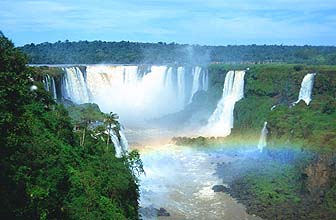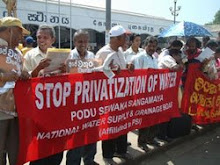Now, with all the historical turmoil that Paraguay has undergone a few more human rights violations don't seem like such a big deal. However, let's not take this situation lightly, for the privatization of water in the country's capital is not just a passing phase. This conflict has been a hot debate for years, and it's not settling down any time soon.
Let's start from the beginning...
What is privatization?
 Well-- simply put: A basic definition for privatization in the water or sanitation sector involves transferring some or all of the assets or operations of public water systems into private hands.This does not necessarily mean the privatization of water resources themselves occurs because water services are seen as such a key public service. Proposals for privatization of them often evoke stronger opposition than for other sectors. Globally, over two-thirds of modern water and sanitation systems are publicly owned and operated.
Well-- simply put: A basic definition for privatization in the water or sanitation sector involves transferring some or all of the assets or operations of public water systems into private hands.This does not necessarily mean the privatization of water resources themselves occurs because water services are seen as such a key public service. Proposals for privatization of them often evoke stronger opposition than for other sectors. Globally, over two-thirds of modern water and sanitation systems are publicly owned and operated.For more information on the different types of Privatization Models: Click Here! Apply this to water... this taking water and charging the public for how much they use. Water! The public will be charged for the water they drink, bathe in, wash their clothes in and use in cooking...
Here's the Story:
In 1995, the World Bank began a sewerage project in Asuncion which would theoretically give more citizens would have access to sanitation. They sought to introduce private sector participation in water supply and sanitation. The World Bank has since reported that this project failed, but again, in 1999 they tried to convert it into "a vehicle for privatizing the water and telephone companies". (The Paraguayan government changed its mind on whether to refocus the project solely on privatization and eventually the project failed to go ahead.)
This failure to proceed with privatization was one of the reasons that the World Bank reduced its funding in Paraguay between 1999 and 2004.
"Participation of private capital in public infrastructure, as evidenced by, for example, further expansion of water/sanitation services via existing minimum subsidy concession schemes with private operators; taking to point of transaction two PPPs in infrastructure investment."
-World Bank. (2004). Country Assistance Strategy for the Republic of Paraguay 2004/07. World Bank. Washington DC.
In December 2000, PPIAF paid $75,000 (US Dollars) with an additional $15,000 from the World Bank, to fund a consultant to develop options for a concession contract for the primary Paraguayan water utility Corposana. The project also sought to build a consensus on the sector reforms with all the stakeholders, the government, Corposana, the private water providers, and consumer and business groups.
This consensus was supposed to be obtained through a 'participatory approach', but was at odds with PPIAF's assertion that the required outcome was the yielding of Corposana's urban water services to one or more private operators. Corposana's name subsequently changed to Essap.
In June 2002, the concession plans were voted against by the Paraguayan senate, because local unions stood up against water privatization. It became an issue in the 2003 elections, when some candidates and parties were for the privatization and some parties were against it.
After promising not to sell any more state-owned companies, Nicanor Duarte won the presidential election and promptly announced there were no plans to award a private concession contract for Essap. Instead a plan was launched to reform the utility from within the public sector. In February 2004, Jose Alderete, Public Works and Communications Minister, said that the government would be seeking World Bank investment to assist them with reforms in the water sector. BUT the World Bank was clear that privatization would be REQUIRED in order to receive any aid whatsoever. "Some of the additional or deeper policy areas where the Bank has advised the administration to turn its attention ... include ... promotion of public-private partnerships for infrastructure development and maintenance through concession contracts for operation and construction, performance-based maintenance contracts and minimum subsidy concessions for expansion of water and sewerage."
-World Bank. (2004). Country Assistance Strategy for the Republic of Paraguay 2004/07. World Bank. Washington DC.
Over the summer of 2004, those in favor of privatization tried to revamp the policy that was voted down in 2002. Unsurprisingly, 5000 people protested through Asuncion against the law, and it was voted down again.
In September 2005, Business News Americas reported that in discussions over a new back-up plan with the International Monetary Fund, IMF: the Paraguayan government had to draw up plans to introduce private sector investment to four state-owned companies, including Essap. Finance Minister Ernst Bergen was quoted as saying, "We are totally open to private sector participation, with the view that administration is passed to the private sector; so that the private sector has an interest in being involved in these companies."
Wait... what?
Two months later, PPIAF approved a new activity to assist the Paraguayan government in developing a new water strategy to enable the participation of local private sector operators in the country. Consultants paid with $175,000, with an additional $114,200 from other sources, would analyze options to restructure the utilities, and PPIAF funded activity also included building a stake-holder consensus for individual utilities.
In May 2006, a management contract for Essap, along with four other companies was proposed, and supposed to be active by December 2006.
Despite public protest, popular elections, and parliamentary votes, the IMF is still pushing water privatization in Paraguay, a process begun and re-launched by PPIAF.
Now, parliamentary members and civil society organizations, SOBREVIVENCIA (Survival) amongst them, are pressing for the final approval of a new law on water. This will guarantee access to water as a human right, and declare all water a property of the state.What exactly is the deal here? Consider the violation of rights in this situation.
Democracy is being trampled... and now, Asuncion has some of the highest prices for water in South America. Drink it in...
-L
 For more information on the issues within the government of Paraguay and the new president, click here. Hopefully new political rule offers potential for improvement of the resources and quality of life for the people of Paraguay, such as increasing the much needed availability of water and sanitation.
For more information on the issues within the government of Paraguay and the new president, click here. Hopefully new political rule offers potential for improvement of the resources and quality of life for the people of Paraguay, such as increasing the much needed availability of water and sanitation.







